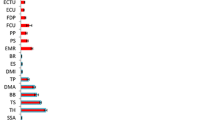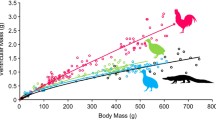Summary
Postnatal changes in wing morphology, flight ability, muscle morphology, and histochemistry were investigated in the little brown bat, Myotis lucifugus. The pectoralis major, acromiodeltoideus, and quadriceps femoris muscles were examined using stains for myofibrillar ATPase, succinate dehydrogenase (SDH), and mitochondrial α-glycerophosphate dehydrogenase (α-GPDH) enzyme reactions. Bats first exhibited spontaneous, drop-evoked flapping behavior at 10 days, short horizontal flight at 17 days, and sustained flight at 24 days of age. Wing loading decreased and aspect ratio increased during postnatal development, each reaching adult range before the onset of sustained flight. Histochemically, fibers from the three muscles were undifferentiated at birth and had lower oxidative and glycolytic capacities compared to other age groups. Cross-sectional areas of fibers from the pectoralis and acromiodeltoideus muscles increased significantly at an age when dropevoked flapping behavior was first observed, suggesting that the neuromuscular mechanism controlling flapping did not develop until this time. Throughout the postnatal growth period, pectoralis and acromiodeltoideus muscle mass and fiber cross-sectional area increased significantly. By day 17 the pectoralis muscle had become differentiated in glycolytic capacity, as indicated by the mosaic staining pattern for α-GPDH. By contrast, the quadriceps fibers were relatively large at birth and slowly increased in size during the postnatal period. Fiber differentiation was evident at the time young bats began to fly, as indicated by a mosaic pattern of staining for myosin ATPase. These results indicate that flight muscles (pectoralis and acromiodeltoideus) are less well developed at birth and undergo rapid development just before the onset of flight. By contrast the quadriceps femoris muscle, which is required for postural control, is more developed at birth than the flight muscles and grows more slowly during subsequent development.
Similar content being viewed by others
References
Anthony ELP, Kunz TH (1977) Feeding strategies of the little brown bat, Myotis lucifugus, in southern New Hampshire. Ecology 54:775–786
Armstrong, RB, Ianuzzo CD, Kunz TH (1977) Histochemical and biochemical properties of flight muscle fibers in the little brown bat, Myotis lucifugus. J Comp Physiol 119:141–154
Bourne GH (1972) The structure and function of muscle. 2nd ed. Academic Press, New York
Brooke MH, Kaiser KK (1974) The use and abuse of muscle histochemistry. Ann NY Acad Sci 228:121–144
Brown PE, Brown TW, Grinnell AD (1983) Echolocation, development and vocal communication in the lesser bulldog bat, Noctilio albiventris. Behav Ecol Sociobiol 13:287–298
Buchler ER (1980) The development of flight, foraging, and echolocation in the little brown bat (Myotis lucifugus). Behav Ecol Sociobiol 6:211–218
Chiakulas JJ, Pauly JE (1965) A study of postnatal growth of skeletal muscle in the rat. Anat Rec 152:55–62
Close R (1964) Dynamic properties of fast and slow skeletal muscles of the rat during development. J Physiol 173:74–75
Dubowitz V (1965) Enzyme histochemistry of skeletal muscle. J Neurol Neurosurg Psychiat 28:516–524
Faulkner JA, White TP (1990) Adaptations of skeletal muscle to physical activity. In: Bouchard C, Shephard TJ, Stephens T, Sutton JR, McPherson BD (eds) Exercise, fitness and health: a consensus of current knowledge. Human Kinetics Publishers, Champaign, Illinois, pp 265–279
Fenton MB (1990) The foraging behavior and ecology of animal-eating bats. Can J Zool 68:411–422
Fenton MB, Barclay RMR (1980) Myotis lucifugus. Mamm Spec 142:1–8
Foehring RC, Hermanson JW (1984) Morphology and histochemistry of flight muscles in free-tailed bats, Tadarida brasiliensis. J Mammal 65:388–394
George JC, Jyoti D (1955) Histological features of the breast and leg muscle of bird and bat and their physiological and evolutionary significance. J Anim Morphol Physiol 2:31–36
George JC, Naik RM (1957) Studies on the structure and physiology of flight muscles of bats. 1. The occurrence of two types of fibers in the pectoralis major muscle of the bat Hipposideros speoris, their relative distribution, nature of fuel store and mitochondrial content. J Anim Morphol Physiol 4:96–101
George JC, Talesara CL (1961) The succinic dehydrogenase levels of the pectoral muscles of a few representative types of birds and a bat in relation to the fibre diameter, muscle weight and body weight. Comp Biochem Physiol 3:267–273
George JC, Susheela AK, Scaria KS (1958) Studies on the structure and physiology of the flight muscles of bats. 3. Alkaline phosphatase and succinic dehydrogenase activity in the breast muscle — a histochemical study. J Anim Morphol Physiol 5:110–112
Goldspink G (1969) Succinic dehydrogenase content of individual muscle fibers at different ages and stages of growth. Life Sci 8:791–808
Guth L, Samaha FJ (1972) Erroneous interpretations which may result from application of the ‘myofibrillar ATPase’ histochemical procedure to developing muscle. Exp Neurobiol 34:465–475
Gutmann E, Melichna J, Syrovy I (1974) Developmental changes in contraction time, myosin properties, and fibre pattern of fast and slow skeletal muscles. Physiol Bohem 23:19–27
Hermanson JW, LaFramboise WA, Daaod MJ (1991) Uniform myosin isoforms in the flight muscles of little brown bats, Myotis lucifugus. J Exp Biol (in press)
Hill AV (1965) The diffusion of oxygen through tissues. In: Trails and trials in physiology, a bibliography. Williams and Wilkins, Baltimore, pp 208–241
Hughes PM, Ransome RD, Jones G (1989) Aerodynamic constraints on flight ontogeny in free-living greater horseshoe bats, Rhinolophus ferrumequinum. In: Hanak V, Horacek I, Gaisler J (eds) European bat research 1987. Charles Univ Press, Praha, Czechoslovakia, pp 255–262
Jones C (1967) Growth, development, and wing loading in the evening bat, Nycticebus humeralis (Rafinesque). J Mammal 48:1–19
Jones MM (1982) Growth of the pectoralis muscle of the house sparrow (Passer domesticus). J Anat 135:719–731
Konstantinov AI (1973) Development of echolocation in bats in postnatal ontogenesis. Period Biol 75:13–19
Kratky J (1981) Postnatale Entwicklung der Wasserfledermaus, Myotis daubentoni Kuhl, und bisherige Kenntnis dieser Problematik im Rahmen der Unterordnung Microchiroptera (Mammalia: Chiroptera). Fol Mus Rer Natur Bohem Occid Pizen Zool 16:3–34
Kunz TH (1973) Population studies of the cave bat (Myotis velifer): reproduction, growth and development. Occas Pap Mus Nat Hist, Univ Kansas 15:1–43
Kunz TH, Anthony ELP (1982) Age estimation and post-natal growth in the bat Myotis lucifugus. J Mammal 63:23–32
Kurta A, Kunz TH (1987) Size of bats at birth and maternal investment during pregnancy. Symp Zool Soc Lond 57:79–106
Laframboise WA, Daood MJ, Futherie RD, Butler-Browne GS, Whalen RG, Ontell M (1990) Myosin isoforms in neonatal rat extensor digitorum longus, diaphragm, and soleus muscles. Am J Physiol 259: L116-L122
Muller BD, Baldwin J (1978) Biochemical correlates of flying behavior in bats. Aust J Zool 26:29–37
Neuweiler G (1989) Foraging ecology and audition in echolocating bats. Trends Ecol Evol 4:160–166
Norberg UM (1981) Allometry of bat wings and legs and comparison with bird wings. Phil Trans R Soc Lond B 292:359–398
Norberg UM (1990) Vertebrate flight: mechanics, physiology, morphology, ecology, and evolution. Springer, Berlin Heidelberg New York
Norberg UM, Rayner JMV (1987) Ecological morphology and flight in bats (Mammalia; Chiroptera): wing adaptations, flight performance, foraging strategy and echolocation. Phil Trans R Soc Lond 6316:335–427
O'Brien RAD (1983) Postnatal development of the innervation of mammalian skeletal muscle. In: Burnstock G, O'Brien T, Vrbova G (eds) Somatic and autonomie nerve-muscle interactions. Elsevier Science Publishers, London, pp 153–184
O'Connor RJ (1977) Differential growth and body composition in altricial passerines. Ibis 119:147–166
O'Farrell J, Studier EH (1973) Reproduction, growth, and development in Myotis thysanodes and M. lucifugus (Chiroptera: Vespertilionidae). Ecology 54:18–30
Ogata Y (1988) Morphological and cytochemical features of fiber types in vertebrate skeletal muscle. Crit Rev Anat Cell Biol 1:229–275
Ohtsu R, Uchida TA (1979) Correlation among fiber composition and LDH isozyme patterns of the pectoralis muscles and flight habits in bats. J Fac Agr, Kyushu Univ 24:157–163
Ohtsu R, Mori T, Uchida TA (1978) Electron microscopical and biochemical studies of the major pectoral muscles of bats. Comp Biochem Physiol 61:101–107
Pearse AGE (1961) Direct relationship of phosphorylase and mitochondrial alpha-glycerophosphate dehydrogenase activity in skeletal muscle. Nature (Lond) 191:504
Peter JB, Barnard RJ, Edgerton VR, Gillespie CA, Stempel KE (1972) Metabolic profiles of three fiber types of skeletal muscle in guinea pigs and rabbits. Biochem 11:2627–2633
Pette D, Spamer C (1979) Metabolic subpopulations of muscle fibres; a quantitative study. Diabetes 28:25–29
Provine RR (1981) Development of wing-flapping and flight in normal and flap-deprived domestic chicks. Dev Psychobiol 14:279–291
Rother G, Schmidt U (1985) Die ontogenetische Entwicklung der Vokalisation bei Phyllostomus discolor (Chiroptera). Z Säugetierk 50:17–26
Rubenstein NA, Kelly AM (1978) Myogenic and neurogenic contributions to the development of fast and slow twitch muscles in the rat. Dev Biol 62:473–485
Schiaffino S, Bormioli SP (1973) Adaptive changes in developing rat skeletal muscle in response to functional overload. Exp Neurol 40:126–137
Shear CR, Goldspink G (1971) Structural and physiological changes associated with the growth of avian fast and slow muscle. Morphology 135:351–372
Strickler TL (1980) Downstroke muscle histochemistry in two bats. In: Wilson DE, Gardner AL (eds) Proceedings of the Fifth International Bat Research Conference, Texas Tech University, Lubbock, pp 61–68
Wattenberg LW, Leong JL (1960) Effects of coenzyme Q10 and menadione on succinic dehydrogenase activity as measured by tetrazolium salt reduction. J Histochem Cytochem 8:296–303
Wirtz P, Loermans HMTh, Peer PGM, Reintjes AGM (1983) Postnatal growth and differentiation of muscle fibres in the mouse. I. A histochemical and morphometrical investigation of normal muscle. J Anat 137:109–126
Yacoe ME, Cummings JW, Myers P, Creighton GK (1982) Muscle enzyme profile, diet, and flight in South American bats. Am J Physiol 242:R189-R194
Yokoyama K, Uchida TA (1979a) Functional morphology of wings from the standpoint of adaptation for flight in Chiroptera. II. Growth and changes in mode of life during the young period in Rhinolophus cornutus cornutus. J Fac Agr, Kyushu Univ 23:185–198
Yokoyama K, Uchida TA (1979b) Ultrastructure of postembryonic development of the pectoralis muscles in the Japanese lesser horseshoe bat, Rhinolophus cornutus cornutus from the standpoint of adaptation for flight. J Fac Agr, Kyushu Univ 24:49–63
Yokoyama K, Ohtsu R, Uchida TA (1979) Growth and LDH isozyme patterns in the pectoral and cardiac muscles of the Japanese lesser horseshoe bat, Rhinolophus cornutus cornutus from the standpoint of adaptation for flight. J Zool 187:85–96
Yokoyama K, Uchida TA, Shiraishi S (1975) Functional morphology of wings from the standpoint of adaptation for flight in Chiroptera. I. Relative growth and ossification in the forelimb, wing loading, and aspect ratio. Zool Mag 84:233–247
Zuurveld JGEM, Wirtz P, Loermans HMTh, Veerkamp JH (1985) Postnatal growth and differentiation in three hindlimb muscles of the rat. Cell Tissue Res 241:183–192
Author information
Authors and Affiliations
Rights and permissions
About this article
Cite this article
Powers, L.V., Kandarian, S.C. & Kunz, T.H. Ontogeny of flight in the little brown bat, Myotis lucifugus: behavior, morphology, and muscle histochemistry. J Comp Physiol A 168, 675–685 (1991). https://doi.org/10.1007/BF00224357
Issue Date:
DOI: https://doi.org/10.1007/BF00224357




